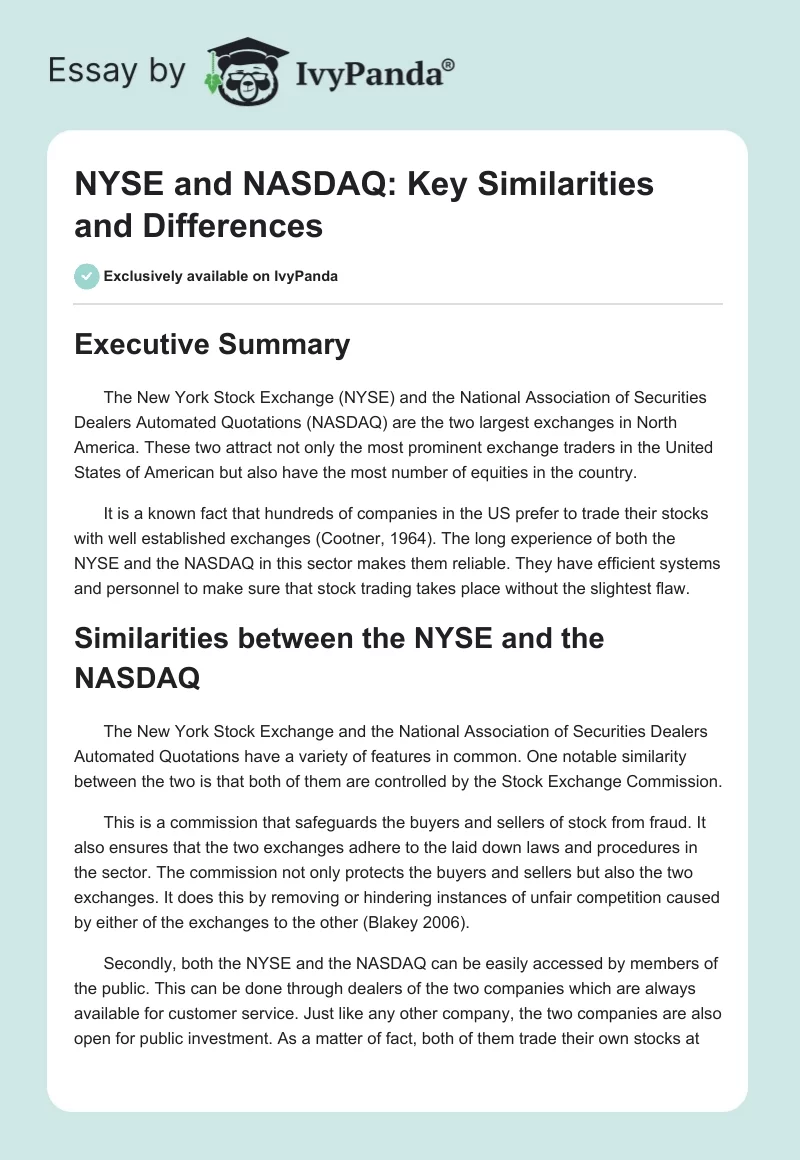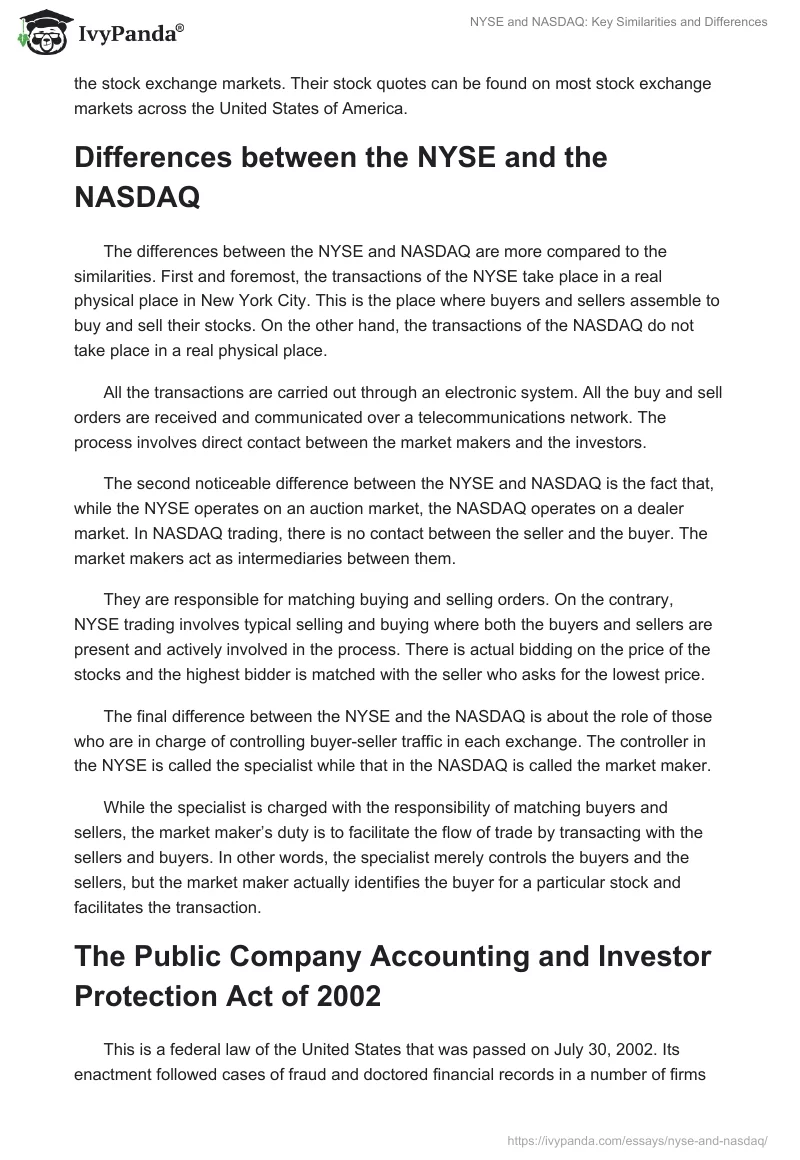Executive Summary
The New York Stock Exchange (NYSE) and the National Association of Securities Dealers Automated Quotations (NASDAQ) are the two largest exchanges in North America. These two attract not only the most prominent exchange traders in the United States of American but also have the most number of equities in the country.
It is a known fact that hundreds of companies in the US prefer to trade their stocks with well established exchanges (Cootner, 1964). The long experience of both the NYSE and the NASDAQ in this sector makes them reliable. They have efficient systems and personnel to make sure that stock trading takes place without the slightest flaw.
Similarities between the NYSE and the NASDAQ
The New York Stock Exchange and the National Association of Securities Dealers Automated Quotations have a variety of features in common. One notable similarity between the two is that both of them are controlled by the Stock Exchange Commission.
This is a commission that safeguards the buyers and sellers of stock from fraud. It also ensures that the two exchanges adhere to the laid down laws and procedures in the sector. The commission not only protects the buyers and sellers but also the two exchanges. It does this by removing or hindering instances of unfair competition caused by either of the exchanges to the other (Blakey 2006).
Secondly, both the NYSE and the NASDAQ can be easily accessed by members of the public. This can be done through dealers of the two companies which are always available for customer service. Just like any other company, the two companies are also open for public investment. As a matter of fact, both of them trade their own stocks at the stock exchange markets. Their stock quotes can be found on most stock exchange markets across the United States of America.
Differences between the NYSE and the NASDAQ
The differences between the NYSE and NASDAQ are more compared to the similarities. First and foremost, the transactions of the NYSE take place in a real physical place in New York City. This is the place where buyers and sellers assemble to buy and sell their stocks. On the other hand, the transactions of the NASDAQ do not take place in a real physical place.
All the transactions are carried out through an electronic system. All the buy and sell orders are received and communicated over a telecommunications network. The process involves direct contact between the market makers and the investors.
The second noticeable difference between the NYSE and NASDAQ is the fact that, while the NYSE operates on an auction market, the NASDAQ operates on a dealer market. In NASDAQ trading, there is no contact between the seller and the buyer. The market makers act as intermediaries between them.
They are responsible for matching buying and selling orders. On the contrary, NYSE trading involves typical selling and buying where both the buyers and sellers are present and actively involved in the process. There is actual bidding on the price of the stocks and the highest bidder is matched with the seller who asks for the lowest price.
The final difference between the NYSE and the NASDAQ is about the role of those who are in charge of controlling buyer-seller traffic in each exchange. The controller in the NYSE is called the specialist while that in the NASDAQ is called the market maker.
While the specialist is charged with the responsibility of matching buyers and sellers, the market maker’s duty is to facilitate the flow of trade by transacting with the sellers and buyers. In other words, the specialist merely controls the buyers and the sellers, but the market maker actually identifies the buyer for a particular stock and facilitates the transaction.
The Public Company Accounting and Investor Protection Act of 2002
This is a federal law of the United States that was passed on July 30, 2002. Its enactment followed cases of fraud and doctored financial records in a number of firms across the nation. The law was enacted at a time when investors and the general public had lost confidence in public firms. This is due to the fact that investors had lost billions of dollars in cases of fraud that affected companies such as WorldCom and Enron. Therefore, the main purpose of the act was to restore the trust that almost everybody had lost in public companies.
The act led to the formation of the Public Company Accounting Oversight Committee (PCAOC). This committee assumes the role of auditors and oversees and regulates accounting firms. The committee is also responsible for registering auditors and inspecting their work in order to vet their quality. Moreover, the committee formulates policies and guidelines that regulate the operations of audit firms.
The act also establishes a set of standards that advocate for the external independence of auditors. This autonomous operation of audit firms is necessary to avoid jeopardizing the genuine results of the audits. It is required that the audit firm should not have any other relations with the same client that it carries out audit services for. This ensures that the two parties only relate professionally hence leading to the submission of genuine financial records.
Conclusion
In conclusion, the New York Stock Exchange (NYSE) and the National Association of Security Dealers Automated Quotations (NASDAQ) share a couple of similarities as well as differences. However, the number of differences exceeds the similarities. From the second part of the report, it is evident that The Public Company Accounting and Investor Protection Act of 2002 has regulated accounting activities and financial records in public companies.
Reference List
Blakey, P. (2006). The efficient market approximation. IEEE Microwave Magazine,7(1), 28–31.
Cootner, P. H. (1964). The random character of stock market prices. Cambridge: The MIT Press.


